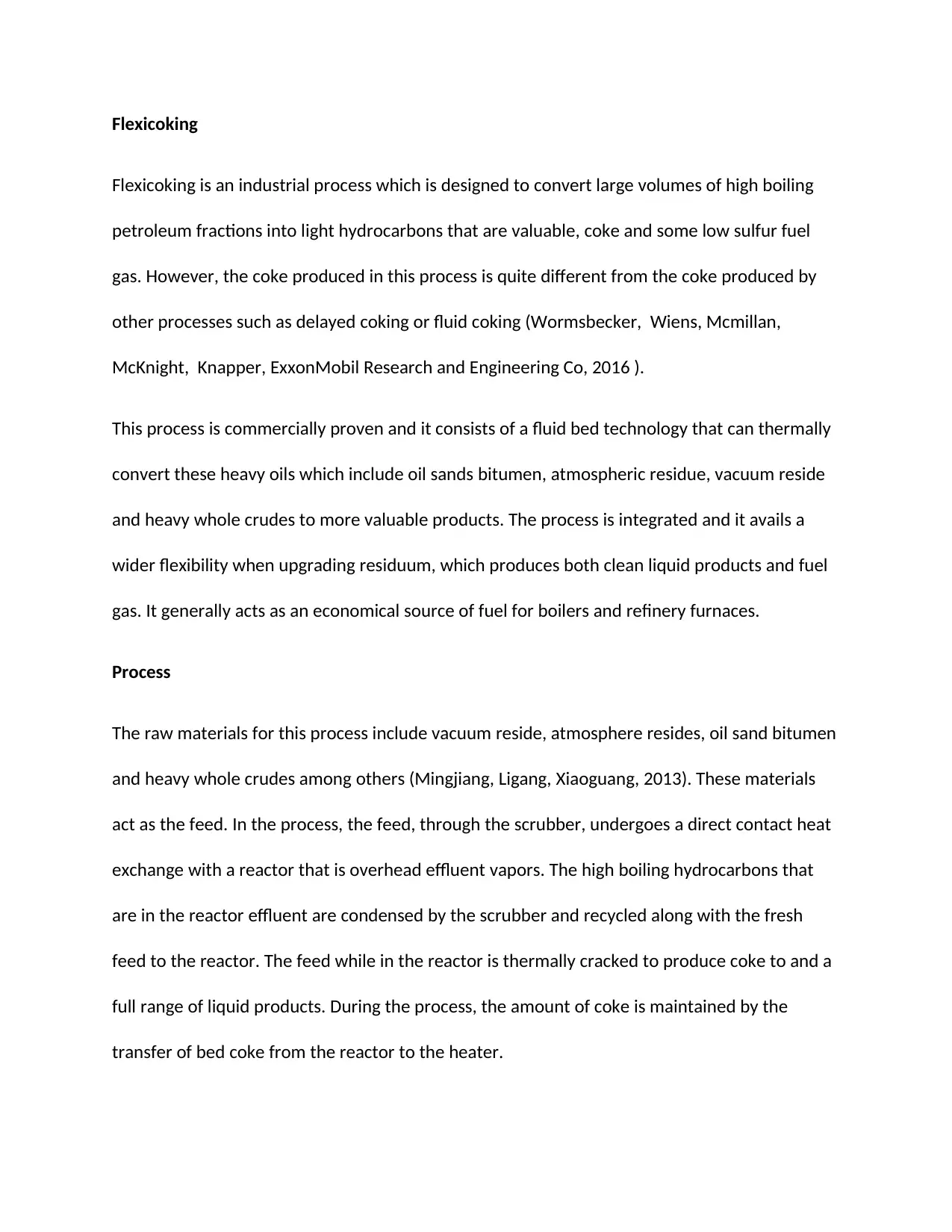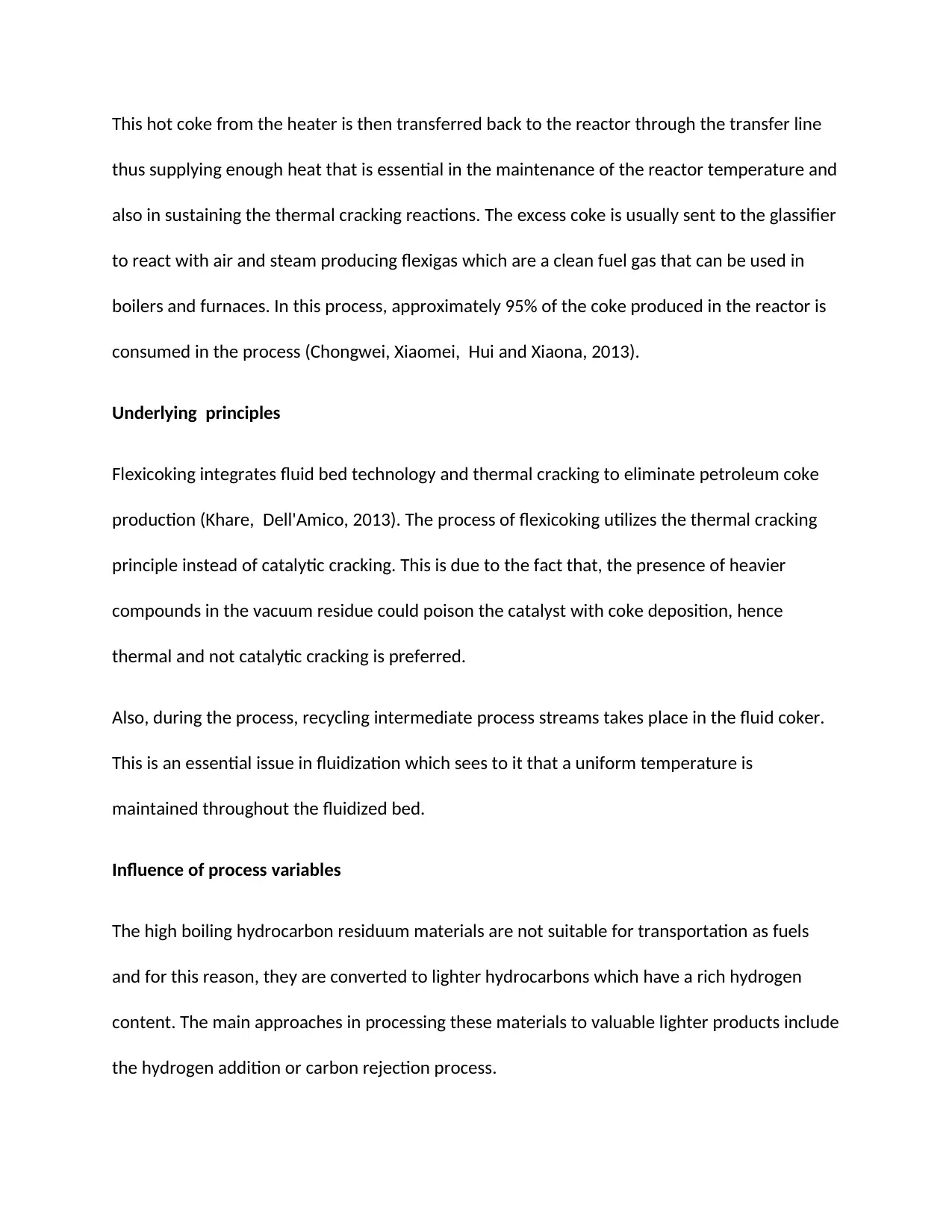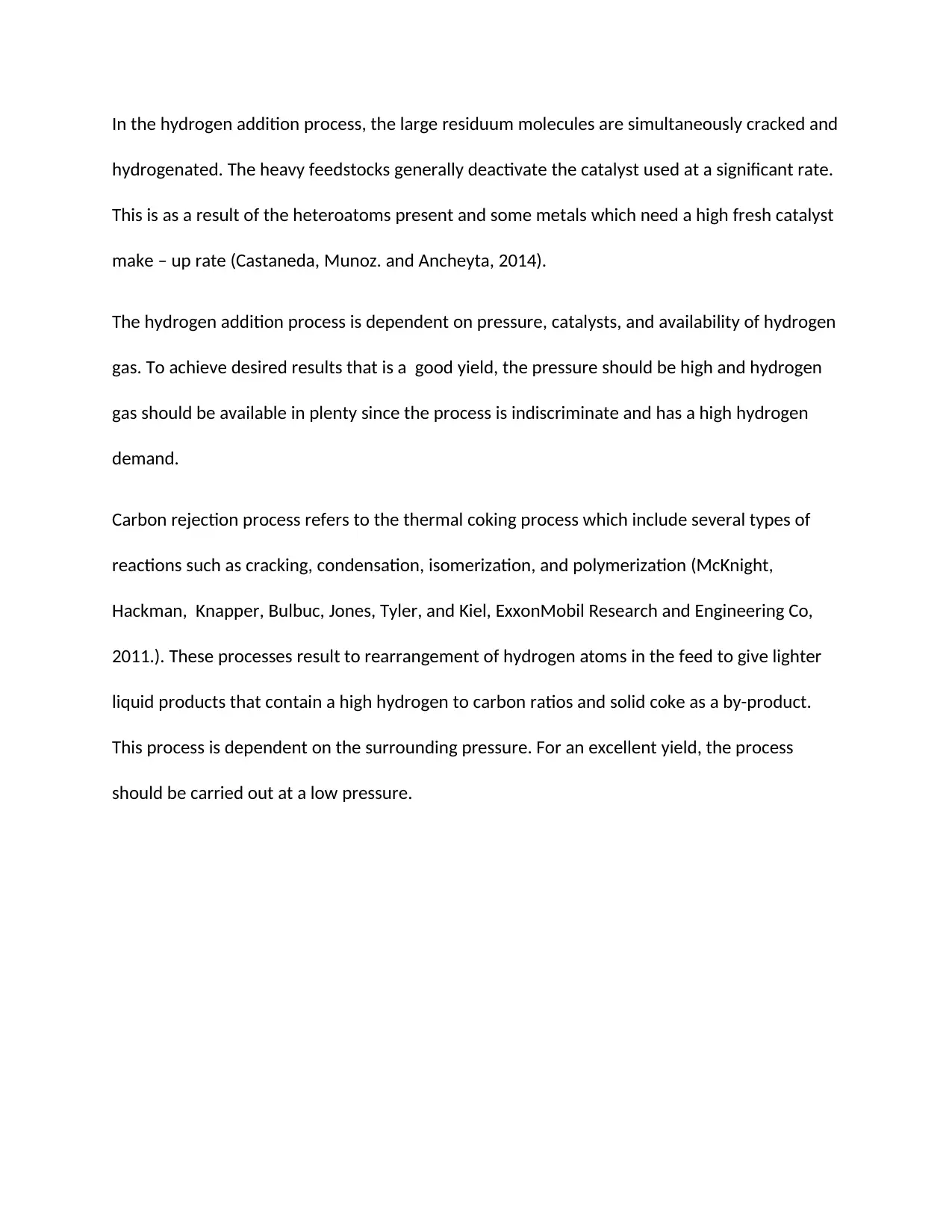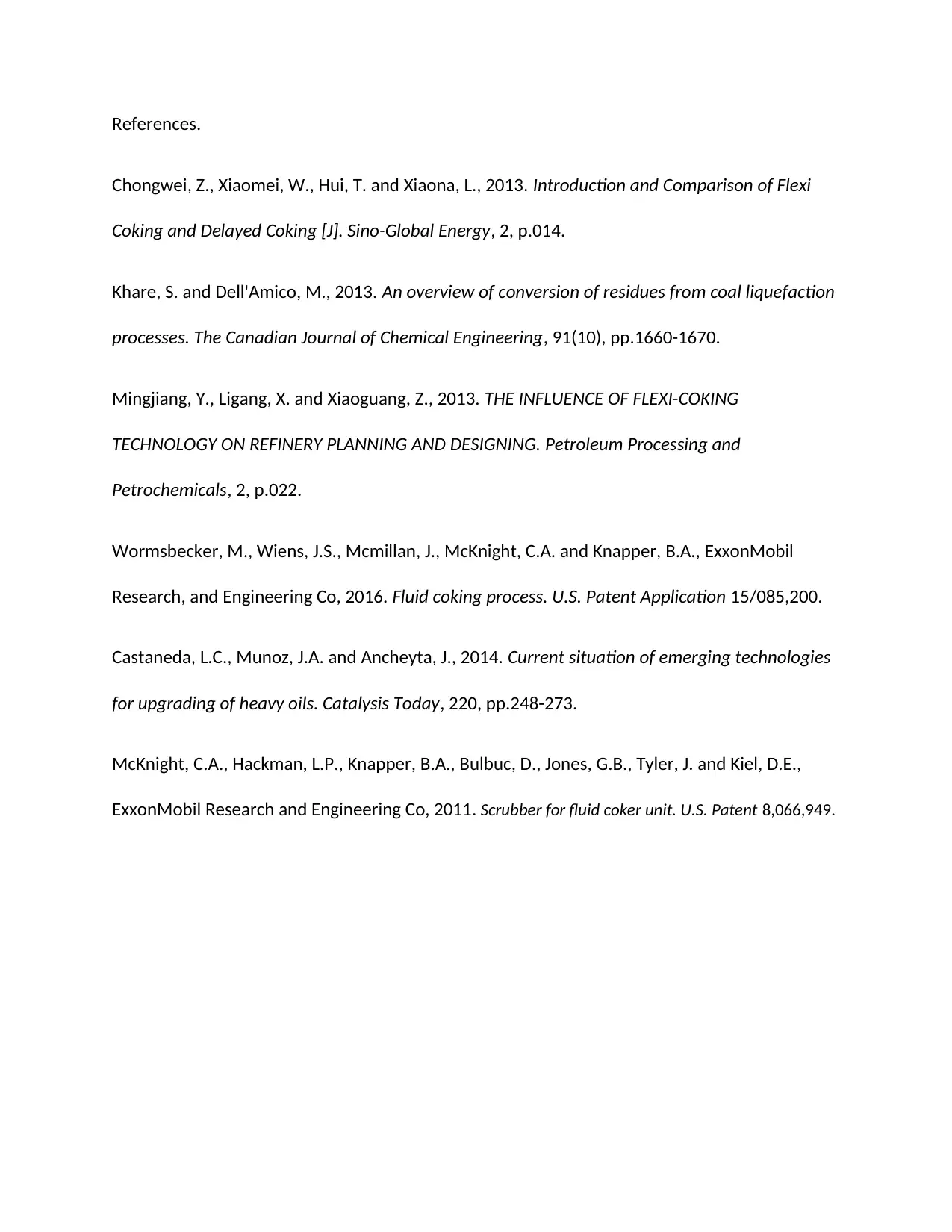Flexicoking: Detailed Analysis of an Industrial Process for Conversion
VerifiedAdded on 2023/06/04
|5
|1013
|188
Report
AI Summary
The Flexicoking process is an industrial method designed to convert high-boiling petroleum fractions into valuable light hydrocarbons, coke, and low-sulfur fuel gas. This commercially proven process utilizes fluid bed technology to thermally convert heavy oils like bitumen and residues. The process involves the thermal cracking of feed in a reactor, with coke transferred to a heater and then back to the reactor to maintain temperature. Excess coke is gasified to produce flexigas. The process integrates fluid bed technology and thermal cracking, relying on thermal cracking due to catalyst poisoning concerns. Key process variables include the hydrogen addition and carbon rejection processes, with the latter preferred for better yields under low pressure. References include patents and academic papers on the process and its variations.

Flexicocking
Name
Professor
Course
Date
Name
Professor
Course
Date
Paraphrase This Document
Need a fresh take? Get an instant paraphrase of this document with our AI Paraphraser

Flexicoking
Flexicoking is an industrial process which is designed to convert large volumes of high boiling
petroleum fractions into light hydrocarbons that are valuable, coke and some low sulfur fuel
gas. However, the coke produced in this process is quite different from the coke produced by
other processes such as delayed coking or fluid coking (Wormsbecker, Wiens, Mcmillan,
McKnight, Knapper, ExxonMobil Research and Engineering Co, 2016 ).
This process is commercially proven and it consists of a fluid bed technology that can thermally
convert these heavy oils which include oil sands bitumen, atmospheric residue, vacuum reside
and heavy whole crudes to more valuable products. The process is integrated and it avails a
wider flexibility when upgrading residuum, which produces both clean liquid products and fuel
gas. It generally acts as an economical source of fuel for boilers and refinery furnaces.
Process
The raw materials for this process include vacuum reside, atmosphere resides, oil sand bitumen
and heavy whole crudes among others (Mingjiang, Ligang, Xiaoguang, 2013). These materials
act as the feed. In the process, the feed, through the scrubber, undergoes a direct contact heat
exchange with a reactor that is overhead effluent vapors. The high boiling hydrocarbons that
are in the reactor effluent are condensed by the scrubber and recycled along with the fresh
feed to the reactor. The feed while in the reactor is thermally cracked to produce coke to and a
full range of liquid products. During the process, the amount of coke is maintained by the
transfer of bed coke from the reactor to the heater.
Flexicoking is an industrial process which is designed to convert large volumes of high boiling
petroleum fractions into light hydrocarbons that are valuable, coke and some low sulfur fuel
gas. However, the coke produced in this process is quite different from the coke produced by
other processes such as delayed coking or fluid coking (Wormsbecker, Wiens, Mcmillan,
McKnight, Knapper, ExxonMobil Research and Engineering Co, 2016 ).
This process is commercially proven and it consists of a fluid bed technology that can thermally
convert these heavy oils which include oil sands bitumen, atmospheric residue, vacuum reside
and heavy whole crudes to more valuable products. The process is integrated and it avails a
wider flexibility when upgrading residuum, which produces both clean liquid products and fuel
gas. It generally acts as an economical source of fuel for boilers and refinery furnaces.
Process
The raw materials for this process include vacuum reside, atmosphere resides, oil sand bitumen
and heavy whole crudes among others (Mingjiang, Ligang, Xiaoguang, 2013). These materials
act as the feed. In the process, the feed, through the scrubber, undergoes a direct contact heat
exchange with a reactor that is overhead effluent vapors. The high boiling hydrocarbons that
are in the reactor effluent are condensed by the scrubber and recycled along with the fresh
feed to the reactor. The feed while in the reactor is thermally cracked to produce coke to and a
full range of liquid products. During the process, the amount of coke is maintained by the
transfer of bed coke from the reactor to the heater.

This hot coke from the heater is then transferred back to the reactor through the transfer line
thus supplying enough heat that is essential in the maintenance of the reactor temperature and
also in sustaining the thermal cracking reactions. The excess coke is usually sent to the glassifier
to react with air and steam producing flexigas which are a clean fuel gas that can be used in
boilers and furnaces. In this process, approximately 95% of the coke produced in the reactor is
consumed in the process (Chongwei, Xiaomei, Hui and Xiaona, 2013).
Underlying principles
Flexicoking integrates fluid bed technology and thermal cracking to eliminate petroleum coke
production (Khare, Dell'Amico, 2013). The process of flexicoking utilizes the thermal cracking
principle instead of catalytic cracking. This is due to the fact that, the presence of heavier
compounds in the vacuum residue could poison the catalyst with coke deposition, hence
thermal and not catalytic cracking is preferred.
Also, during the process, recycling intermediate process streams takes place in the fluid coker.
This is an essential issue in fluidization which sees to it that a uniform temperature is
maintained throughout the fluidized bed.
Influence of process variables
The high boiling hydrocarbon residuum materials are not suitable for transportation as fuels
and for this reason, they are converted to lighter hydrocarbons which have a rich hydrogen
content. The main approaches in processing these materials to valuable lighter products include
the hydrogen addition or carbon rejection process.
thus supplying enough heat that is essential in the maintenance of the reactor temperature and
also in sustaining the thermal cracking reactions. The excess coke is usually sent to the glassifier
to react with air and steam producing flexigas which are a clean fuel gas that can be used in
boilers and furnaces. In this process, approximately 95% of the coke produced in the reactor is
consumed in the process (Chongwei, Xiaomei, Hui and Xiaona, 2013).
Underlying principles
Flexicoking integrates fluid bed technology and thermal cracking to eliminate petroleum coke
production (Khare, Dell'Amico, 2013). The process of flexicoking utilizes the thermal cracking
principle instead of catalytic cracking. This is due to the fact that, the presence of heavier
compounds in the vacuum residue could poison the catalyst with coke deposition, hence
thermal and not catalytic cracking is preferred.
Also, during the process, recycling intermediate process streams takes place in the fluid coker.
This is an essential issue in fluidization which sees to it that a uniform temperature is
maintained throughout the fluidized bed.
Influence of process variables
The high boiling hydrocarbon residuum materials are not suitable for transportation as fuels
and for this reason, they are converted to lighter hydrocarbons which have a rich hydrogen
content. The main approaches in processing these materials to valuable lighter products include
the hydrogen addition or carbon rejection process.
⊘ This is a preview!⊘
Do you want full access?
Subscribe today to unlock all pages.

Trusted by 1+ million students worldwide

In the hydrogen addition process, the large residuum molecules are simultaneously cracked and
hydrogenated. The heavy feedstocks generally deactivate the catalyst used at a significant rate.
This is as a result of the heteroatoms present and some metals which need a high fresh catalyst
make – up rate (Castaneda, Munoz. and Ancheyta, 2014).
The hydrogen addition process is dependent on pressure, catalysts, and availability of hydrogen
gas. To achieve desired results that is a good yield, the pressure should be high and hydrogen
gas should be available in plenty since the process is indiscriminate and has a high hydrogen
demand.
Carbon rejection process refers to the thermal coking process which include several types of
reactions such as cracking, condensation, isomerization, and polymerization (McKnight,
Hackman, Knapper, Bulbuc, Jones, Tyler, and Kiel, ExxonMobil Research and Engineering Co,
2011.). These processes result to rearrangement of hydrogen atoms in the feed to give lighter
liquid products that contain a high hydrogen to carbon ratios and solid coke as a by-product.
This process is dependent on the surrounding pressure. For an excellent yield, the process
should be carried out at a low pressure.
hydrogenated. The heavy feedstocks generally deactivate the catalyst used at a significant rate.
This is as a result of the heteroatoms present and some metals which need a high fresh catalyst
make – up rate (Castaneda, Munoz. and Ancheyta, 2014).
The hydrogen addition process is dependent on pressure, catalysts, and availability of hydrogen
gas. To achieve desired results that is a good yield, the pressure should be high and hydrogen
gas should be available in plenty since the process is indiscriminate and has a high hydrogen
demand.
Carbon rejection process refers to the thermal coking process which include several types of
reactions such as cracking, condensation, isomerization, and polymerization (McKnight,
Hackman, Knapper, Bulbuc, Jones, Tyler, and Kiel, ExxonMobil Research and Engineering Co,
2011.). These processes result to rearrangement of hydrogen atoms in the feed to give lighter
liquid products that contain a high hydrogen to carbon ratios and solid coke as a by-product.
This process is dependent on the surrounding pressure. For an excellent yield, the process
should be carried out at a low pressure.
Paraphrase This Document
Need a fresh take? Get an instant paraphrase of this document with our AI Paraphraser

References.
Chongwei, Z., Xiaomei, W., Hui, T. and Xiaona, L., 2013. Introduction and Comparison of Flexi
Coking and Delayed Coking [J]. Sino-Global Energy, 2, p.014.
Khare, S. and Dell'Amico, M., 2013. An overview of conversion of residues from coal liquefaction
processes. The Canadian Journal of Chemical Engineering, 91(10), pp.1660-1670.
Mingjiang, Y., Ligang, X. and Xiaoguang, Z., 2013. THE INFLUENCE OF FLEXI-COKING
TECHNOLOGY ON REFINERY PLANNING AND DESIGNING. Petroleum Processing and
Petrochemicals, 2, p.022.
Wormsbecker, M., Wiens, J.S., Mcmillan, J., McKnight, C.A. and Knapper, B.A., ExxonMobil
Research, and Engineering Co, 2016. Fluid coking process. U.S. Patent Application 15/085,200.
Castaneda, L.C., Munoz, J.A. and Ancheyta, J., 2014. Current situation of emerging technologies
for upgrading of heavy oils. Catalysis Today, 220, pp.248-273.
McKnight, C.A., Hackman, L.P., Knapper, B.A., Bulbuc, D., Jones, G.B., Tyler, J. and Kiel, D.E.,
ExxonMobil Research and Engineering Co, 2011. Scrubber for fluid coker unit. U.S. Patent 8,066,949.
Chongwei, Z., Xiaomei, W., Hui, T. and Xiaona, L., 2013. Introduction and Comparison of Flexi
Coking and Delayed Coking [J]. Sino-Global Energy, 2, p.014.
Khare, S. and Dell'Amico, M., 2013. An overview of conversion of residues from coal liquefaction
processes. The Canadian Journal of Chemical Engineering, 91(10), pp.1660-1670.
Mingjiang, Y., Ligang, X. and Xiaoguang, Z., 2013. THE INFLUENCE OF FLEXI-COKING
TECHNOLOGY ON REFINERY PLANNING AND DESIGNING. Petroleum Processing and
Petrochemicals, 2, p.022.
Wormsbecker, M., Wiens, J.S., Mcmillan, J., McKnight, C.A. and Knapper, B.A., ExxonMobil
Research, and Engineering Co, 2016. Fluid coking process. U.S. Patent Application 15/085,200.
Castaneda, L.C., Munoz, J.A. and Ancheyta, J., 2014. Current situation of emerging technologies
for upgrading of heavy oils. Catalysis Today, 220, pp.248-273.
McKnight, C.A., Hackman, L.P., Knapper, B.A., Bulbuc, D., Jones, G.B., Tyler, J. and Kiel, D.E.,
ExxonMobil Research and Engineering Co, 2011. Scrubber for fluid coker unit. U.S. Patent 8,066,949.
1 out of 5
Your All-in-One AI-Powered Toolkit for Academic Success.
+13062052269
info@desklib.com
Available 24*7 on WhatsApp / Email
![[object Object]](/_next/static/media/star-bottom.7253800d.svg)
Unlock your academic potential
Copyright © 2020–2025 A2Z Services. All Rights Reserved. Developed and managed by ZUCOL.
